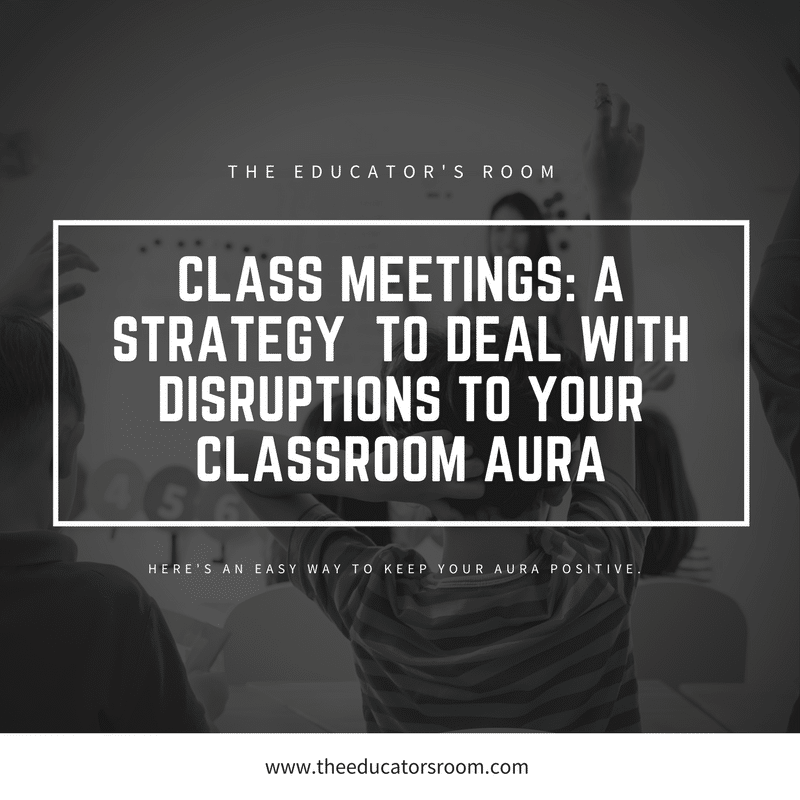The school year is off to a great start. You’ve spent the first few weeks building relationships with your students and creating communities where students can share and feel safe enough to be themselves. Your students are learning about you and your teaching style, while you are learning about their individual learning styles. Everything is going great until… it’s not. There are many events that can disrupt the flow of a classroom including: a new student transfers in, a case of teasing happens in the lunchroom, a student is being excluded by a group of her friends, something is stolen from your desk, etc. All of these events can really shake up the aura of your peaceful classroom community and wreak havoc on what you’ve built- if it’s not addressed and dealt with immediately.
Holding Class Meetings
One way to address the incidents that may disrupt your classroom flow is to hold class meetings. When I was first introduced to this idea, it seemed like common sense to talk about issues with my students, right? However, in recent years, my end goal for these meetings has shifted. When I first started to hold these meetings, my main purpose was to guilt students into admitting what they’ve done wrong. However, according to the Caring School Community program (a research based social emotional program I use), I have learned that the end goal of these class meetings shouldn’t be to identify any perpetrators but to provide an opportunity for students to see why some actions create problems in a community. During these class meetings, the students reflect on the problem, build empathy for those affected, and come up with some solutions. It’s important to note that sometimes these meetings don’t end with a definite solution, but they help raise students’ awareness to problems in their community and how they can have a big impact on the flow of a classroom.
[bctt tweet=”When I first started to hold these meetings, my main purpose was to guilt students into admitting what they’ve done wrong. ” username=””]
I am going to give you a completely hypothetical situation that would warrant a classroom meeting. Say that you notice your Bill Nye the Science Guy Bobble Head (that you absolutely love and was given to you by a former student who still, to this day, sends you Christmas cards) is missing from your desk. You’ve also noticed students complaining about a number of small items that have gone missing from their desks. This would be the time to call a class meeting to discuss the issue of stealing.
What Does a Class Meeting Look Like?
A typical class meeting would start with students sitting in a circle. This allows for students to see each other, and it helps facilitate the flow of ideas. Begin by explaining to students the problem and why it’s important to discuss it. You can simply say, “we are going to discuss the issue of stealing in this classroom because it is hurting members of our community.” Begin by using the “Think, Pair, Share” http://www.readingrockets.org/strategies/think-pair-share strategy, and according to the Caring School Community program, you would ask the following questions:
-Have you ever had something stolen from you? Or seen or heard about someone’s stuff being stolen?
-How did that make you feel?
-Why do you think some kids steal?
-Why don’t we want to steal anything in our classroom?
Let your students discuss the questions and respond to one another. Next, discuss with students ways to deal with stealing. The Caring School Community program suggests you then ask questions like:
-What might you do if you see someone taking something that does not belong to them?
-If someone has something you want, what might you do instead of stealing?
-If you have stolen something in the past, what might you do to make it right?
-How might you feel if you took something that wasn’t yours, and didn’t try to make it right?
-How might you feel after you tried to make it right?
Finally, have students recap what was discussed and let them add any concluding remarks they may want. Of course, sometimes the classroom thief may step forward, but always keep in mind, that’s not the goal of the meeting and the goal is to make students feel comfortable enough to not only avoid these behaviors but to stop other students.
In the end, class meetings are an easy way to help students help themselves so I have to ask, how do you hold class meetings?
References:
Developmental Studies Center. Caring School Community Class Meetings (kit) 2016. Emeryville, CA







